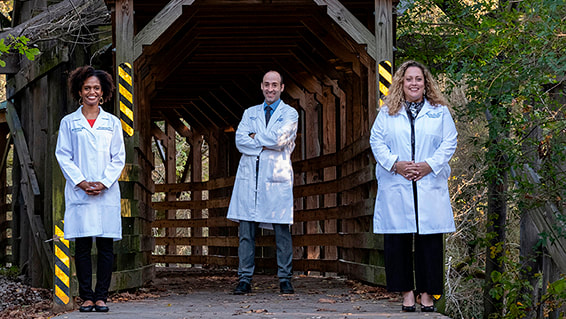The Community Approach to Cancer Treatment in Midtown
Left to right: Joy Summers, Zachary Bercu, and Kelda Kemp
The Division of Interventional Radiology (IR) provides image-guided diagnostic and therapeutic procedures for cancer patients in collaboration with Winship Cancer Institute at Emory University Hospital and Emory University Hospital Midtown. The IR team takes a community approach at Emory Midtown, where patients from Kaiser Permanente and Atlanta Veterans Administration Hospital come for procedures like Y-90 radioembolization to treat inoperable liver cancer.
“We work closely with our referring community doctors to ensure the highest quality continuity of care,” explains Zachary Bercu, MD, assistant professor and assistant division director for innovation and strategy of Emory Interventional Radiology.
Teamwork is vital given the COVID-19 pandemic. What once took several visits now must occur in one day to minimize infection risk. The compressed schedule means less travel for critically ill patients and less time without anti-angiogenic medications they must pause for treatment. It also means up to five patients can be treated in one long day.
Dosimetry is an important patient safety factor, says Nima Kokabi, MD, assistant professor and interim clinical site director for IR at Emory Midtown. He pioneered clinical trials to determine the lowest dose of radiation needed to destroy a tumor while minimizing damage to healthy tissue. The team also must match procedure scheduling with delivery of the radioactive isotope yttrium Y-90 so patients receive the optimal dosage. Nurse navigator Sonia Benenati does more than coordinate scheduling: patients also turn to her for help with quality of life issues.
On treatment day, Drs. Bercu and Kokabi map the tumor using angiography. Emory Radiology’s nuclear medicine specialists Dr. David Schuster, Dr. David Brandon, and Dr. Ila Sethi then help determine dosing and placement of tiny beads filled with Y-90. Nuclear medicine technologists Kawai Laurencin and Nancy Hicks provide the CT/PET imaging the radiologists need to guide placement of the Y-90 beads to treat the tumor. The nursing team monitors the patient post-procedure; side effects are treated before patients leave. Nurse practitioner Kelda Kemp and physician assistant Joy Summers provide aftercare through virtual visits. Referring doctors appreciate how the Emory team shares details about a patient’s treatment and consults on next steps.
“Our whole team works to ensure a seamless, safe experience for the patient,” says Dr. Bercu. The result is more months of living for patients who thought they were out of options.
“We work closely with our referring community doctors to ensure the highest quality continuity of care,” explains Zachary Bercu, MD, assistant professor and assistant division director for innovation and strategy of Emory Interventional Radiology.
Teamwork is vital given the COVID-19 pandemic. What once took several visits now must occur in one day to minimize infection risk. The compressed schedule means less travel for critically ill patients and less time without anti-angiogenic medications they must pause for treatment. It also means up to five patients can be treated in one long day.
Dosimetry is an important patient safety factor, says Nima Kokabi, MD, assistant professor and interim clinical site director for IR at Emory Midtown. He pioneered clinical trials to determine the lowest dose of radiation needed to destroy a tumor while minimizing damage to healthy tissue. The team also must match procedure scheduling with delivery of the radioactive isotope yttrium Y-90 so patients receive the optimal dosage. Nurse navigator Sonia Benenati does more than coordinate scheduling: patients also turn to her for help with quality of life issues.
On treatment day, Drs. Bercu and Kokabi map the tumor using angiography. Emory Radiology’s nuclear medicine specialists Dr. David Schuster, Dr. David Brandon, and Dr. Ila Sethi then help determine dosing and placement of tiny beads filled with Y-90. Nuclear medicine technologists Kawai Laurencin and Nancy Hicks provide the CT/PET imaging the radiologists need to guide placement of the Y-90 beads to treat the tumor. The nursing team monitors the patient post-procedure; side effects are treated before patients leave. Nurse practitioner Kelda Kemp and physician assistant Joy Summers provide aftercare through virtual visits. Referring doctors appreciate how the Emory team shares details about a patient’s treatment and consults on next steps.
“Our whole team works to ensure a seamless, safe experience for the patient,” says Dr. Bercu. The result is more months of living for patients who thought they were out of options.
